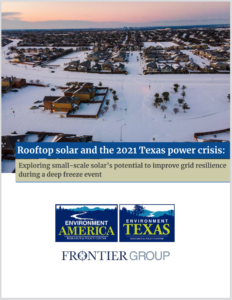Full Title: Rooftop Solar and the 2021 Texas Power Crisis: Exploring Small-Scale Solar's Potential to Improve Grid Resilience During a Deep Freeze Event
Author(s): Emma Searson, Tony Dutzik, Bryn Huxley-Reicher
Publisher(s): Environment America, Environment Texas, Frontier Group
Publication Date: February 10, 2022
Full Text: Download Resource
Description (excerpt):
Solar energy is a remarkable resource. It is abundant – the U.S. has the technical potential to meet its 2020 electricity needs 78 times over with solar power alone. As a clean and renewable energy source that can help reduce reliance on dirty fossil fuels, it helps reduce pollution and protect the environment. Rooftop solar is particularly environmentally friendly, since it takes advantage of already-developed rooftops and leaves open spaces undisturbed. One additional benefit that small-scale, distributed solar offers to communities is helping to relieve strain on the power grid during times of stress. This paper explores how maximizing rooftop solar potential could magnify that particular benefit, using the 2021 Texas power crisis as a case study.
In total, Texas’s technical potential for rooftop solar generation alone is 97,800 MW – more than 15 times the total installed capacity at the time of the 2021 power crisis. This amount of rooftop solar could produce the equivalent of about one third of the state’s total electricity use in 2020.
Our paper finds that tapping Texas’s full rooftop solar potential would have made a world of difference during the February 2021 freeze. There were 13 days during mid- to late February during which power production fell short of forecasted demand; On 11 of those days, rooftop solar could have supplied more than enough power to meet the daily shortfall in power demand, on aggregate. And, during the two days when the gap between supply and demand was greatest (Feb 15-16, 2021), rooftop solar could still have made up between 40%- 60% of the gap.
